Your Planets
Portraits of the Planets
Aspects between Planets
The planetary ages
The planetary families
Planets in Signs
The Planets in comics


The orbs allowed for the Interplanetary Aspects are one of the major problems facing astrology. Without theory, it seems insoluble. With a rational theory, this problem can be solved.
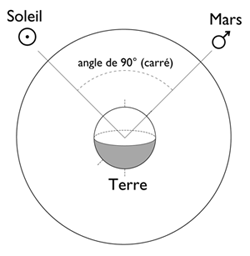 - Astronomically, an Aspect is a specific angle (or angular distance) that two or more stars form with respect to the center of the Earth. It is expressed in degrees and minutes of arc. All the angles (from 0° to 360°) that the stars can form between them are not Aspects.
- Astronomically, an Aspect is a specific angle (or angular distance) that two or more stars form with respect to the center of the Earth. It is expressed in degrees and minutes of arc. All the angles (from 0° to 360°) that the stars can form between them are not Aspects.
▶ Astrologically, an Aspect is a connection between two or more psychological poles represented by two Planets.
▶ An Aspect is not a fixed angle between two points on a circle, but a dynamic phase, characteristic of a moment of the intercycle between two stars.
▶ The “Aspects to angles” (for example, a trine or a square connecting a Planet to the Ascendant point) do not exist in reality… or at least, not in the form that we believe.
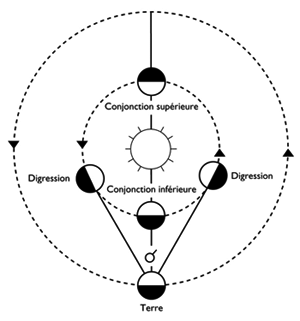 We distinguish the planets “interior” (Mercury and Venus, whose orbit is between that of the Earth and the Sun) and the “outer” planets (from Mars to Pluto inclusive, whose orbits are outside the Earth’s orbit). From a geocentric point of view, Mercury and Venus never move far from the Sun. The maximum difference is about 25° for Mercury: there is therefore only one possible Sun-Mercury Aspect: the conjunction. On the other hand, the maximum angular deviation Venus-Sun reaches approximately 46°, i.e. the value of an “minor” Aspect, the semi-square.
We distinguish the planets “interior” (Mercury and Venus, whose orbit is between that of the Earth and the Sun) and the “outer” planets (from Mars to Pluto inclusive, whose orbits are outside the Earth’s orbit). From a geocentric point of view, Mercury and Venus never move far from the Sun. The maximum difference is about 25° for Mercury: there is therefore only one possible Sun-Mercury Aspect: the conjunction. On the other hand, the maximum angular deviation Venus-Sun reaches approximately 46°, i.e. the value of an “minor” Aspect, the semi-square.
A Sun-Mercury or Sun-Venus conjunction is said to be “superior” when Mercury or Venus are found “behind” the Sun (the Sun is then between the Earth and Mercury or Venus) and “lower” when they are between the Earth and the Sun. The outer planets can form all possible Aspects.
The Aspects result from the division of the intercycle between two celestial bodies by the whole numbers. They are divided into two groups: Aspects “major” and the Aspects “minors”.
Major Aspects are so called because their influence is more powerful than that of minor ones. Dividing the intercycle by the first 4 integers (1, 2, 3 & 4) gives the four most powerful Aspects ((conjunction, opposition, trine, square):
▶ Conjunction: 360/1 = 360° ou 0°
▶ Opposition: 360/2 = 180°
▶ Trine: 360/3 = 120°
▶ Square: 360/4 = 180°
No Aspect corresponds to division by 5 (72°), by 7 (51.42°), by 9 (40°) or by 11 (32.72°). This is due to the fact that the 4 prime numbers are “founders”, and that they imply the sequence of Aspects when they are divided by 2 or by 22 (i.e. 2 multiplied by itself). In effect:
▶ Sextile = (360/3) / 2 = 60°
▶ Semi-square: (360/4) / 2 = 45°
▶ Semi-sextile: (360/3) / (2 × 2) = 30°
▶ Demi-semi-square: (360/4) / (2 × 2) = 22.50°
The semi-semi-square closes the series of Minor Aspects; indeed, with 22.50°, we approach the maximum orb of conjunction and opposition. For many astrologers, this maximum orb cannot exceed 10° (or even 8° for the most restrictive) on either side of the exact Aspect. In reality, observation and practice show that a conjunction or an opposition are always effective up to 15° orb… or even beyond. Indeed, if we remain in the same mathematical sequence of divisions by 4 first integers by the powers of 2, the ultra-maximal orb of conjunction or opposition would be between 15° (value of half-semi-sextile) and 22.50°, i.e. (15° + 22.50°) / 2 = 18.75°. You therefore do not risk making a mistake by admitting an orb of 18° for major celestial phenomena, such as conjunctions-oppositions between fast Planets or angular Planets.
On the other hand, the sesqui-square (135°) and the quincunx (150°), which many astrologers consider to be Aspects, do not enter this harmonic family: indeed, they do not result from a division of the circle by prime numbers, but of proportions:
▶ Sesqui-square: 135° = 3/4 of 180°
▶ Quincunx: 150° = 5/3 of 90°
These two so-called Aspects… are therefore not Aspects, and therefore should not be taken into account.
In practice, it is better to retain only the major Aspects; in a more subtle and refined interpretation and above all in certain very precise conditions (Minor Aspects linking 2 dominant Planets for example), the semi-square can be used (no more than 2° of maximum orb)… remembering not that the more one moves away from the divisor 1 (conjunction), and the more the influence of the Aspects decreases. Take the example of a chart with Mars in Capricorn in the MC in House IX and the Moon in Pisces in the DS in House VII for a geographical latitude of 45° North. They are both dominant; they form an Aspect of 46° 25′, so in the orb of the semi-square. In the interpretation of this chart, it is therefore necessary to take into account the dissonant Aspect which connects them.
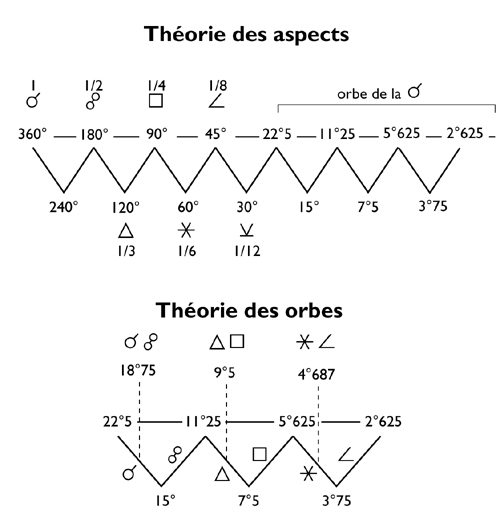 It is not necessary that an Aspect be exact for it to be effective and that one admits an orb of influence before and after the exact Aspect. The question of orbs and their limits is a major problem in astrology.
It is not necessary that an Aspect be exact for it to be effective and that one admits an orb of influence before and after the exact Aspect. The question of orbs and their limits is a major problem in astrology.
The theory of orbs derives from that of the Aspects, since it is based on the harmonics of multiples of 2.
▶ The orb of the conjunction is thus necessarily situated between (360/16) = 22.5° and 360/24) = 15°. It is the same for the opposition. Which limit to choose? Practice seems to show that 22.5° is too much and 15° is not enough. The arithmetic mean of these two orbs gives (22.5° + 15°) / 2 = ±18.75°, which seems to correspond to the observable limit in practice.
▶ The orbs of the square (360/4) and the trine (360/3) necessarily lie between (360/32) = 11.25° and (360/48) = 7.5° (arithmetic mean: 9.375°) or between (360/48) = 7.5° and (360/64) = 5.625° (arithmetic mean: 6.65625°). Practice seems to show that the first hypothesis is correct (±9.375°).
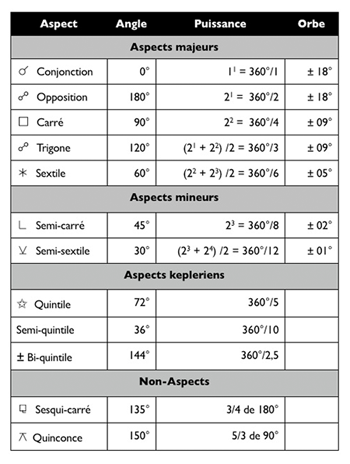 - The orb of the sextile (360/6) necessarily lies between (360/64) = 5.625° and (360/96) = 3.75° (arithmetic mean: 4.6875°), which seems to be confirmed by the practical: (±4.6875°).
- The orb of the sextile (360/6) necessarily lies between (360/64) = 5.625° and (360/96) = 3.75° (arithmetic mean: 4.6875°), which seems to be confirmed by the practical: (±4.6875°).
In practice, it seems that the orbs of slow planets should be reduced. The table opposite gives you the recommended orbs for the Aspects.
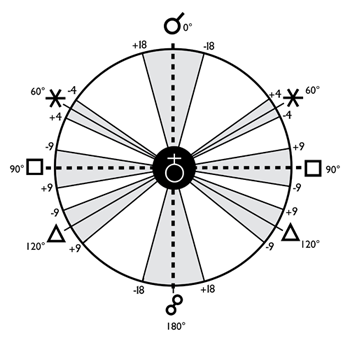
Major or minor, the Aspects are divided into two groups: consonants and dissonants, by analogy with musical vocabulary. In music, a consonance is an affinity between two or more sounds from which results a certain fusion in unity of harmonic perception, while a dissonance is a ratio of sounds which disturbs the ear of the listener. The consonant Aspects (consonant conjunction, sextile, trine) therefore fluidly combine the influences of two or more planets, while the dissonant (dissonant conjunction, square, opposition) are likely to create “hiccups” disharmonious between two or more planetary functions. But the most adequate and precise terms to define the Aspects are undoubtedly those of “continuity” and of “discontinuity”.
The consonant Aspects express a continuity between two or more planetary functions: a continuous relationship is an example of ruptures, fractures, conflictuality. Under a Sun-Mars trine, for example, there is continuity between the objectives that we set for ourselves a priori (Sun) and the concrete means of action (Mars) — we therefore know how to adapt our objectives to the realities on the ground without losing sight of them) —, or even the image we have of ourselves (Sun) and the way in which we behave in lived experience (Mars) — so there is no distortion between what we appear to be and what we actually are.
Dissonant Aspects express a discontinuity between two or more planetary functions. A discontinuous relationship involves interruptions, blockages, functional irregularities. Let’s go back to our example: under a square Sun-Mars, there is discontinuity, hiatus between the objectives that I set myself a priori and my concrete means of action, between my brand image and my experience. This discontinuity can lead to different behavioral scenarios: if I maintain my a priori objectives (Sun) when I do not have the concrete means to achieve them (Mars), I run the risk of failing in my heroic undertakings for lack of realism. and adaptability to circumstances. If, on the contrary, I focus on what I can really achieve concretely, I risk, caught in the heat of the moment, neglecting or forgetting my initial goals. If my image that I have and give of myself (Sun) is in discontinuity with my experience (Mars), I can either give of myself an image of myself that does not correspond in any way with what I really am in my actions, or act without taking into account the image that I give of myself… at the risk of being very “frowned upon”!
The dissonant Aspects thus express a discontinuity, a discordance, an imbalance. Is it serious, or even “malefic”, doctor? Not necessarily. Let’s take the example of a very banal human activity: walking. Walking is managing a permanent imbalance, a dynamic discontinuity between the right and left part of my body. In order not to fall, I have to coordinate the extension and retraction of the muscles of my legs well: one, two, one, two… Having dissonant Aspects in your natal chart is a bit like learning to walk. At the beginning, we break our heads, we take neuro-psychological gadins, by badly coordinating the planetary functions in square or in opposition, we malfunction, we don’t know on which foot to lean: the left? The right? Ahead? Backward?
Dissonances, as we can see, are not comfortable a priori. Neither can learning to walk… and yet, after a variable amount of time depending on the individual, all those who have functioning legs end up, bumping into each other, learning to walk. The same goes for dissonances: an individual born with a Sun-Mars square will initially have great difficulty coordinating these two functions. Then, as he grows older and accumulates experience, he will get there little by little. For example, he will know better than anyone the gap that can exist between the image we have of others (Sun) and what they are concretely in existence (Mars); he will know that there is a time to appear (Sun) and a time to act (Mars).
Obviously, if the individual does not learn to walk with his dissonances and to make them work, he is in great danger of developing neuroses, a planetary function then expressing itself unilaterally at the expense of the other, which it denies, locks or repels. If my solar function suppresses my marsian function for a time or for a long time, I will constantly strive to give an image of myself that in no way corresponds to the reality of my experience; tense on my certainties, my principles, my appearance (Sun), I will end up deserting my instincts, refusing the duels and confrontations inherent in existence (repression of Mars). Conversely, if Mars is repelling the Sun, I will act aggressively, through and through (Mars) without any purpose, ideal or guiding principle (Repressed Sun), violently and instinctively opposing (Mars) any form of authority (Sun).
But these are extreme cases. As the astrologer rightly notes J.-P. Nicola, “It therefore seems that by creating an imbalance or a difficult situation, the dissonant Aspect mobilizes compensating and supercompensating resources that do not exist in the sky but in man.” If you have plenty of squares in your chart, then all is not lost!
Conjunction is an ambivalent Aspect; indeed, it contains within its orb all the consonant and dissonant micro-Aspects. How to evaluate, given its ambivalent character, if a conjunction is consonant or dissonant? Simplifying, we admit that a conjunction receiving a maximum of consonant Aspects is consonant; it is the opposite if it receives a maximum of dissonant Aspects. If it receives as much or nearly as much dissonance as consonance, consider both the consonant interpretation and the dissonance interpretations.
Another factor can decide the rather consonant or rather dissonant nature of the conjunction: the position of the Planets in Signs. When two planets are in conjunction in the same Sign, they have the same zodiacal rhythm: this common point goes in the direction of consonance; if they are in two different Signs, they do not have the same rhythm, which is an indication of dissonance.
Take the example of the chart of Francis Cabrel: the Moon in Cancer is joined to Jupiter in Gemini. These two Signs are located on either side of the summer solstice. The Moon in Cancer has a waning rhythm (at the beginning of summer, the length of days is decreasing) while Jupiter in Gemini has an increasing rhythm (at the end of spring, the length of days is still increasing). While a Moon-Cancer encourages you to withdraw into your protective shell (Cancer) to have peace (Moon), a Jupiter-Gemini pushes you to exteriorize yourself in all directions (Gemini) to have your works recognized (Jupiter). These two poles of Cabrel’s personality are necessarily contradictory… thus the singer alternates between periods of self-sufficiency in his family and his village (Lune-Cancer) and his triumphant tours where he extroverts himself by putting himself on stage (Jupiter-Gemini).
This conjunction between two Planets in two different Signs therefore has a dissonant character, all the more so since the Moon is squared with Mars. But it also has a consonant character, due to the trines it receives from Mercury-Venus-Saturn-Neptune.
.png)
.png)
.png)
In general, all the conjunctions which occur astride the axis of the equinoxes (Pisces-Aries, Virgo-Libra) and the solstice axis (Gemini-Cancer, Sagittarius-Capricorn) can be considered as having a strongly dissonant character if they receive a maximum of dissonant Aspects. It is a little less true in the other cases. Take the case of a conjunction between a Moon in Aries and a Jupiter in Taurus: Aries is an opening sign and Taurus a closing sign. It is therefore an index of dissonance; but in Aries as in Taurus, the duration of the dominant days is increasing: these two Signs, and therefore the Planets in conjunction which occupy them, therefore have a point in common, which is a consonant factor. If this conjunction receives a maximum of consonant Aspects, the dissonance will be lessened; if it receives a maximum of dissonant Aspects, the dissonance will be reinforced.
As we have already seen, not all Aspects of a chart have the same relative power. We thus distinguish the Strong Aspects, which concern the dominant character traits or the astro-psychological functions that we most frequently express; Average Aspects, which correspond to certain traits of our personality that appear less often in our behaviors; and finally the Weak Aspects, which illustrate the astro-psychological functions that we rarely or never use, those therefore that we “look alike” the least.
Like the Signs of the zodiac, the Aspects represent the characteristic phases of the cycle of a Planet: during a complete cycle, it passes successively through the 12 Signs and the 8 major Aspects (conjunction, 1st increasing sextile, 1st increasing square, 1st ascending trine, opposition, 2nd descending trine, 2nd descending square, 2nd descending sextile and return to conjunction).
The chart therefore forms an inseparable whole, a dynamic representation of time through the Planetary intercycles (Aspects) and zodiacal phases (Signs).
▶ Aspects theory and practice
▶ Les aspects, phases d’un cycle
▶ Aspects : existe-t-il un modèle traditionnel ?
▶ Aspects : théorie et bilan conditionaliste
▶ Introduction à l’interprétation des aspects
▶ The planetary Aspects and their orbs
▶ Les Aspects kepleriens
▶ Les “aspects” aux Angles
▶ Chronologie des Aspects et Transits
▶ A brief history of interplanetary aspects
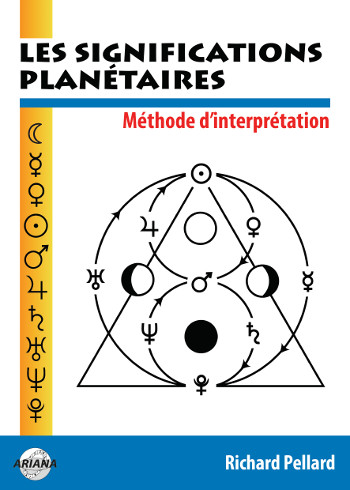
Les significations planétaires
par
620 pages. Illustrations en couleur.
La décision de ne traiter dans ce livre que des significations planétaires ne repose pas sur une sous-estimation du rôle des Signes du zodiaque et des Maisons. Le traditionnel trio Planètes-Zodiaque-Maisons est en effet l’expression d’une structure qui classe ces trois plans selon leur ordre de préséance et dans ce triptyque hiérarchisé, les Planètes occupent le premier rang.
La première partie de ce livre rassemble donc, sous une forme abondamment illustrée de schémas pédagogiques et tableaux explicatifs, une édition originale revue, augmentée et actualisée des textes consacrés aux significations planétaires telles qu’elles ont été définies par l’astrologie conditionaliste et une présentation détaillée des méthodes de hiérarchisation planétaire et d’interprétation accompagnées de nombreux exemples concrets illustrés par des Thèmes de célébrités.
La deuxième partie est consacrée, d’une part à une présentation critique des fondements traditionnels des significations planétaires, d’autre part à une présentation des rapports entre signaux et symboles, astrologie et psychologie. Enfin, la troisième partie présente brièvement les racines astrométriques des significations planétaires… et propose une voie de sortie de l’astrologie pour accéder à une plus vaste dimension noologique et spirituelle qui la prolonge et la contient.
Téléchargez-le dès maintenant dans notre boutique
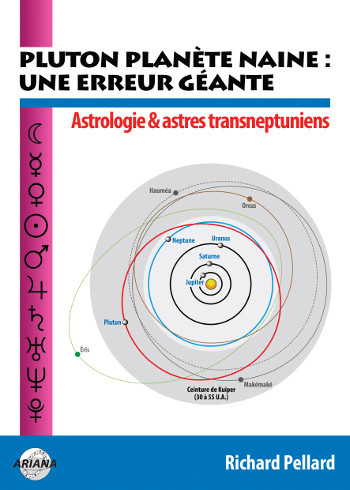
Pluton planète naine : une erreur géante
par
117 pages. Illustrations en couleur.
Pluton ne fait plus partie des planètes majeures de notre système solaire : telle est la décision prise par une infime minorité d’astronomes lors de l’Assemblée Générale de l’Union Astronomique Internationale qui s’est tenue à Prague en août 2006. Elle est reléguée au rang de “planète naine”, au même titre que les nombreux astres découverts au-delà de son orbite.
Ce livre récapitule et analyse en détail le pourquoi et le comment de cette incroyable et irrationnelle décision contestée par de très nombreux astronomes de premier plan. Quelles sont les effets de cette “nanification” de Pluton sur son statut astrologique ? Faut-il remettre en question son influence et ses significations astro-psychologiques qui semblaient avérées depuis sa découverte en 1930 ? Les “plutoniens” ont-ils cessé d’exister depuis cette décision charlatanesque ? Ce livre pose également le problème des astres transplutoniens nouvellement découverts. Quel statut astrologique et quelles influences et significations précises leur accorder ?
Enfin, cet ouvrage propose une vision unitaire du système solaire qui démontre, chiffes et arguments rationnels à l’appui, que Pluton en est toujours un élément essentiel, ce qui est loin d’être le cas pour les autres astres au-delà de son orbite. Après avoir lu ce livre, vous saurez quoi répondre à ceux qui pensent avoir trouvé, avec l’exclusion de Pluton du cortège planétaire traditionnel, un nouvel argument contre l’astrologie !
Téléchargez-le dès maintenant dans notre boutique